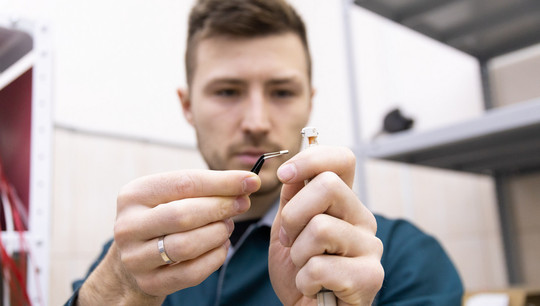Ural Federal University Develops New Material for Potential Use as Membrane in Nuclear Reactors
The new proton conductor developed by Ural scientists can be used as a separation membrane for hydrogen isotopes. This will make it possible to extract deuterium and tritium from the gas mixture and then use them for their intended purpose – either to recycle or to use. The scientists’ development can be used in nuclear power plants (NPPs) to improve the efficiency of chemical separation. The scientists have published detailed information about the new conductor and its benefits in Ceramics International.
“Our material can be used as a functional material in nuclear energy. The fact is that during the operation of a nuclear reactor, a radioactive isotope of hydrogen, tritium, is released, which needs to be properly utilized. Our material can act as a membrane capable of electrochemically pumping the tritium out of the supplied gas mixture. This makes it possible to use the tritium as a fuel for fusion reactors, depending on the task”, explains George Starostin, Junior Researcher at the Hydrogen Energy Research Laboratory of UrFU.
A separation membrane has been created to separate individual components and, in the case of proton-conducting membranes, to separate hydrogen isotopes. According to the scientists, a membrane made of the created material will make it possible to optimize the separation process and obtain pure isotopes that can be used in thermonuclear reactions.
“Normally, all proton-conducting materials have better conductivity for light hydrogen isotopes. However, we found that our material was more efficient at transporting heavy hydrogen-deuterium. Thus, our material may be promising for making separation membranes in a nuclear reactor; it is capable of electrochemically pumping out radioactive tritium from the supplied gas mixture”, explains George Starostin.
A proton-conducting material based on barium stannate was obtained by classical solid-phase synthesis with the addition of lutetium as an impurity, which increased the conductivity of the starting material by a factor of five.
“Solid-phase synthesis is the process of creating materials by mixing solids and heating them to high temperatures, typically on the order of 1500°C. We believe that the material we have obtained also has prospects for use as a component of a high-temperature electrochemical sensor sensitive to hydrogen-containing compounds, including deuterium and tritium”, says George Starostin.
The research was carried out by scientists from UrFU together with colleagues from the Institute of High–Temperature Electrochemistry of the Ural Branch of the Russian Academy of Sciences.

